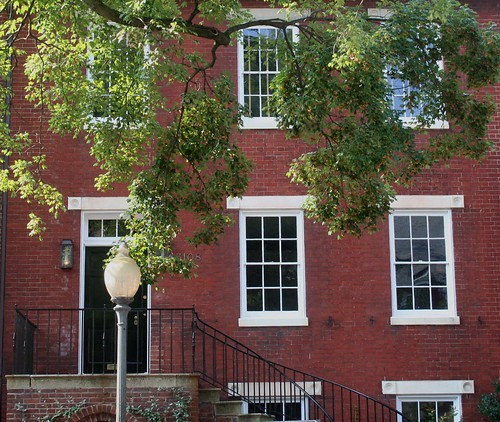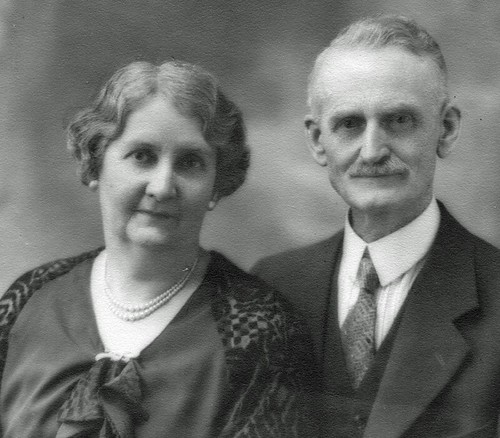Roundup: Dawsey leads Cottonwood past Providence
D.D. Dawsey scored 26 and Alex Morris 12 to lead Cottonwood past Providence Christian 61-56 on Tuesday night in high school basketball action.
Read more on Dothan Eagle
Gen. George H. Thomas

Image by dbking
Former home of:
General George H. Thomas (Civil War General)
Location: 3108 P Street NW
George Henry Thomas (July 31, 1816 – March 28, 1870), the "Rock of Chickamauga", was a career U.S. Army officer and a Union general during the American Civil War, one of the principal commanders in the Western Theater.
Thomas was born in Newsom’s Depot, Southampton County, Virginia. In 1831, Thomas, his sisters, and his widowed mother were forced to flee from their home and hide in the nearby woods in the wake of Nat Turner’s slave rebellion. Graduating from the U.S. Military Academy in 1840, he served as an artillery subaltern in the war against the Seminole Indians in Florida (1841), and in the Mexican War at the battles of Fort Brown, Resaca de la Palma, Monterrey, and Buena Vista, receiving three promotions for distinguished gallantry in action. From 1851 to 1854 he was an instructor at West Point. In 1855 he was appointed a major of the 2nd U.S. Cavalry (later redesignated the 5th U.S. Cavalry) by Jefferson Davis, then Secretary of War. On August 26, 1860, Thomas was wounded by a Indian arrow passing through the flesh near his chin area and sticking into his chest at Clear Fork, Brazos River, Texas.
At the outbreak of the Civil War, three of Thomas’s regimental superiors—Albert Sidney Johnston, Robert E. Lee, and William J. Hardee—resigned. Many Southern-born generals were torn between loyalty to their states and loyalty to their country. Thomas struggled with the decision but opted to remain with the United States. In response, his family turned his picture against the wall, destroyed his letters, and never spoke to him again. Nevertheless, Thomas stayed in the Union Army with some degree of suspicion surrounding him. On January 18, 1861, a few months before Fort Sumter, he had applied for a job as the commandant of cadets at Virginia Military Institute. Any real tendency to the secessionist cause, however, could be refuted when he turned down Virginia Governor John Letcher’s offer to become chief of ordnance for the Virginia Provisional Army.
Thomas was promoted in rapid succession to be lieutenant colonel (April 25, 1861) and colonel (May 3) in the Regular Army, and brigadier general of volunteers (August 17). In the First Manassas campaign, he commanded a brigade under Major General Robert Patterson in the Shenandoah Valley, but all of his subsequent assignments were in the Western Theater. In command of an independent force in eastern Kentucky, on January 18, 1862, he defeated Confederate Generals George B. Crittenden and Felix Zollicoffer at Mill Springs, gaining the first important Union victory in the war, breaking Confederate strength in eastern Kentucky, and lifting Union morale.
On December 2, 1861, Brig. Gen. Thomas was assigned to command the 1st Division of Don Carlos Buell’s Army of the Ohio. He was present at the second day of the Battle of Shiloh (April 7, 1862), but arrived after the fighting had ceased. The victor at Shiloh, Maj. Gen. Ulysses S. Grant, came under severe criticism for the bloody battle and his superior, Henry W. Halleck, reorganized his Department of the Mississippi to ease Grant out of direct field command. The three armies in the department were divided and recombined into three "wings". Thomas, promoted to major general effective April 25, 1862, was given command of the Right Wing, consisting of four divisions from Grant’s former Army of the Tennessee and one from the Army of the Ohio. Thomas successfully led this putative army in the siege of Corinth. On June 10, Grant returned to command of the original Army of the Tennessee.
Thomas resumed service under Don Carlos Buell. During Confederate General Braxton Bragg’s invasion of Kentucky in the fall of 1862, the Union high command became nervous about Buell’s cautious tendencies and offered command of the Army of the Ohio to Thomas, who refused. Thomas served as Buell’s second-in-command at the Battle of Perryville; although tactically inconclusive, the battle halted Bragg’s invasion of Kentucky as he voluntarily withdrew to Tennessee. Again frustrated with Buell’s ineffective pursuit of Bragg, the Union replaced him with Maj. Gen. William Rosecrans.
Fighting under Rosecrans in the newly renamed Army of the Cumberland, Thomas gave an impressive performance at the Battle of Stones River, holding the center of the retreating Union line and once again preventing a victory by Bragg. He was in charge of the most important part of the maneuvering from Decherd to Chattanooga during the Tullahoma Campaign (June 22 – July 3, 1863) and the crossing of the Tennessee River. At the Battle of Chickamauga on September 19, 1863, he once again held a desperate position against Bragg’s onslaught while the Union line on his right collapsed rallying broken and scattered units together on Horseshoe Ridge to prevent a significant Union defeat from becoming a hopeless rout. Future president James Garfield, a field officer for the Army of the Cumberland, visited Thomas during the battle, carrying orders from Rosecrans to retreat; when Thomas said he would have to stay behind to ensure the Army’s safety, Garfield told Rosecrans that Thomas was "standing like a rock. After the battle he became widely known by the nickname "The Rock of Chickamauga", representing his determination to hold a vital position against strong odds.
Thomas succeeded Rosecrans in command of the Army of the Cumberland shortly before the Battle of Chattanooga (November 23 – November 25, 1863), a stunning Union victory that was highlighted by Thomas’s troops storming the Confederate line on Missionary Ridge. As the Army of the Cumberland advanced further than ordered, General Grant, on Orchard Knob asked Thomas, "Who ordered the advance?" Thomas replied, "I don’t know. I did not."
In William Tecumseh Sherman’s advance through Georgia in the spring of 1864, the Army of the Cumberland numbered over 60,000 men, and Thomas’s staff did the logistics and engineering for Sherman’s entire army group. At the Battle of Peachtree Creek (July 20, 1864) Thomas’s defense severely damaged John B. Hood’s army in its first attempt to break the siege of Atlanta.
When Hood broke away from Atlanta in the autumn of 1864, menaced Sherman’s long line of communications, and endeavored to force Sherman to follow him, Sherman abandoned his communications and embarked on the March to the Sea. Thomas stayed behind to fight Hood in the Franklin-Nashville Campaign. Thomas, with a smaller force, raced with Hood to reach Nashville, where he was to receive reinforcements.
At the Battle of Franklin on November 30, 1864, a large part of Thomas’s force, under command of John M. Schofield, dealt Hood a strong defeat and held him in check long enough to cover the concentration at Nashville. At Nashville, Thomas had to organize his forces, drawn from all parts of the West and including many young troops and even quartermaster employees. He declined to attack until his army was ready and the ice covering the ground had melted enough for his men to move. The North, including General Grant himself (now general-in-chief of all Union armies), grew impatient at the delay. Maj. Gen. John A. Logan was sent with an order to replace Thomas, and soon afterwards Grant started a journey west from City Point, Virginia to take command in person.
Thomas attacked on December 15, 1864, in the Battle of Nashville and destroyed Hood’s command. Thomas sent his wife, Frances Lucretia Kellogg, the following telegram, the only communication surviving of the Thomas’s correspondence: "We have whipped the enemy, taken many prisoners and considerable artillery."
For this brilliant victory Thomas was made a major general in the regular army and received the thanks of Congress:
… to Major-General George H. Thomas and the officers and soldiers under his command for their skill and dauntless courage, by which the rebel army under General Hood was signally defeated and driven from the state of Tennessee.
Thomas also received another nickname from his victory: "The Sledge of Nashville".
After the end of the Civil War, Thomas commanded military departments in Kentucky and Tennessee until 1869. President Andrew Johnson offered Thomas the rank of lieutenant general—with the intent to eventually replace Grant, a Republican and future president, with Thomas as General in Chief—but the ever-loyal Thomas asked the Senate to withdraw his name for that nomination because he did not want to be party to politics. In 1869 he requested assignment to command the Division of the Pacific with headquarters at San Francisco. He died there of a stroke, while writing an answer to an article criticizing his military career, on March 28, 1870. He was buried in Oakwood Cemetery, in Troy, New York.
Lillian C. Buttre’s 1877 portrait of Thomas.His cadets at West Point gave him the nickname of "Slow Trot Thomas", and this sobriquet was used to diminish his reputation. He moved slowly because of an injured back, but he was mentally anything but slow, only methodical. He was known for accurate judgment and thorough knowledge of his profession and once he grasped a problem and the time was right for action, he would strike a vigorous, rapid blow.
The veterans’ organization for the Army of the Cumberland, throughout its existence, fought to see that he was honored for all he had done.
Thomas was in chief command of only two battles in the Civil War, the Battle of Mill Springs at the beginning and the Battle of Nashville near the end. Both were victories. However, his contributions at the battles of Stones River, Chickamauga, Chattanooga, and Peachtree Creek were decisive. His main legacies lay in his development of modern battlefield doctrine and in his mastery of logistics.
Thomas has generally been held in high esteem by Civil War historians; Bruce Catton and Carl Sandburg wrote glowingly of him, and many consider Thomas one of the top three Union generals of the war, after Grant and William Tecumseh Sherman. But Thomas never entered the popular consciousness like those men. The general destroyed his private papers, saying he did not want "his life hawked in print for the eyes of the curious." Beginning in the 1870s, many Civil War generals published memoirs, justifying their decisions or refighting old battles, but Thomas, who died in 1870, obviously could not publish his own memoirs.
Grant and Thomas also had a cool relationship, for reasons that are not entirely clear, but are well-attested by contemporaries. When a rain-soaked Grant arrived at Thomas’s headquarters before the Chattanooga campaign, Thomas, caught up in other activity, did not acknowledge the general for several minutes until an aide intervened. Thomas’s perceived slowness at Nashville—although necessitated by the weather—drove Grant into a fit of impatience, and Grant nearly replaced Thomas. In his Personal Memoirs, Grant tended to minimize Thomas’s contributions, particularly during the Franklin-Nashville Campaign, saying his movements were "always so deliberate and so slow, though effective in defence." Sherman, who had been close to Thomas throughout the war, also repeated the accusation after the war that Thomas was "slow", and this damning with faint praise tended to affect perceptions of the Rock of Chickamauga well into the 20th century.
A fort south of Newport, Kentucky was named in his honor, and the city of Fort Thomas now stands there and carries his name as well. A memorial honoring General Thomas can be found in the eponymous Thomas Circle in downtown Washington, D.C.
A very distinctive engraved portrait of Thomas appeared on U.S. paper money in 1890 and 1891. The bills are called "treasury notes" and are widely collected today. These rare notes are considered by many to be among the finest examples of detailed engraving ever to appear on banknotes.
Text Source: Wikipedia
Grandma Grandpa Watson 50th Wedding Anniversary

Image by bill barber
Watson Family History
Thomas Watson (born 1798, died 1875) and Jane Collier (born 1807, died 1896) were raised in County Armagh, Ireland, and came to Canada in early 1843. Their son, from whom we are descended, was William Watson, who was sixteen when the family emigrated. William's brother, Richard, and his sister, Rachel, were older.
The family first settled in Gananoque, and came later to Reading Corner, where they farmed on the fourteenth line, lot six. Richard Watson had a son named Nelson, who died young, and a daughter named Jane, who lived in the Okanogan Valley in British Columbia. Rachel married John Byrne of Hillsburg, who owned a carriage works. The Byrnes had sons: William and John, who remined bachelors.
William, married Sarah Jane Donaldson, a young widow (Mrs. J. Moody) with a daughter: Sarah Jane Moody, who married George Lindsay in 1886, having met him in Cookstown while visiting her father’s family.
The Lindsays had one son, William Donaldson Lindsay., born August 11, 1886. They first lived in London, Ontario; then moved to Kendries, Idaho, and finally settled near Los Angeles, California.
My great grandfather, Thomas Watson, was next in this family.
He married Adeline East, and had two children, Hazel and Bill (my grandfather).
After Thomas came James Donaldson Watson (1872-1944). He married Belle McGee (1880-1958). They had two sons: James Ivan and Glen.
Next came Rachel (1874-1952). On March 6, 1895, she married John Scott at her home in Reading Garafraxa. They had four sons: Thomas Howard, Cecil, George and James
Next in the Watson Family was William George, (1880-1943). His wife was Mabel Patterson (1880). Their daughter was Sarlizabeth.
The youngest of the family was Letitia (1887-1931) In 1910, she married Russell Thurston. The children were: Donaldson, Donna, Robert Russell, Pauline, Roland, Bernice, Mel and Pat.
William Watson's wife, Jane Collier Watson, was one of six sisters and one brother (Robert). Three of the Collier sisters were: Mrs. William Manley (Shelburne area), Mrs. Henderson and Mrs. Leeson. Two young Leeson boys were drowned one Christmas day when they broke through the ice while sliding and skating.
#Win a copy of TickTock by James Patterson! US and CANADA http://wp.me/p10r9i-vB ends 01/21 #giveaway – by bullittmilner (Pauline Milner)
Is it just me, or does James Patterson write a new book like every 3 days? good for him but I'm not intestested unless it's Maximum Ride. – by mcr666 (Amanda H (mcr666))
Finished reading Cross Fire by James Patterson. Ok..probably not award winner though. – by Tina_read2learn (Tina Eisenbraun)
James Patterson Trivia!
james patterson is one of the best mystery writers of this decade…alex cross is my fav charactor followed by the womans murder club…let me know what you think
Answer by nater4817
Arsene Lupin is a great character in M. LeBlanc’s novels.

No comments:
Post a Comment